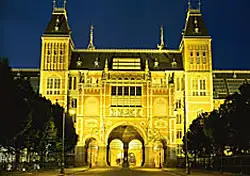
Amsterdam is a laboratory of progressive living and tolerance, bottled inside Europe’s most 17th-century city. Like Venice, this city is a patchwork quilt of canal-bordered islands, anchored upon millions of wooden pilings. But unlike its dwelling-in-the-past cousin, Amsterdam sees itself as a city of the future. And after years of reshuffling and rebuilding, Amsterdam is coming together—2013 is shaping up to be a big year for finally completing several ambitious projects.
People who love Dutch art are thrilled that next April, the new, much-improved Rijksmuseum will open—10 years after it closed for a radical renovation. Built in 1885 to house the nation’s great art, the Rijksmuseum owns an incomparable collection of 17th-century Dutch Masters: Rembrandt, Vermeer, Hals, and Steen. But earlier renovations chopped up the original space into narrow, sparse galleries. So officials moved the masterpieces into its smaller Philips Wing and tore apart the main structure.
When it reopens, the Rijksmuseum will match the vision of its original architect, Pierre Cuypers. Natural light will flood large rooms with high ceilings. These viewing galleries will surround two massive courtyards that were walled up for half a century. Visitors will wander through Neo-Gothic halls with Romantic murals that were painted over in the post-war era. On the bottom floor, there’ll be a bright, new level for visitors with information desks, a café, and gift shop. The collection will be completely arranged. Only Rembrandt’s masterpiece—The Night Watch—will stay in its original position at the center of the building.
Another of Amsterdam’s top draws—the Van Gogh Museum—is also temporarily closed while workers upgrade its infrastructure. Fortunately, 75 of Vincent’s masterpieces are on display in the Hermitage Amsterdam museum instead. Shortly after the Rijksmuseum opens next spring, the Van Gogh Museum will reopen to kick off its 40th birthday celebration.
Those industrious Dutch have already finished upgrading a third Amsterdam art museum. The Stedelijk—the Netherlands’ top modern-art museum—opened its doors in September after a long remodel. Its original building now flaunts an architecturally daring new entry to its fun, far-out, and refreshing exhibits.
While Amsterdam spiffs up its museum quarter, the skyline across the water from its train station has a new focal point—the Film Museum on the IJ, nicknamed “The Eye.” This striking and sleek modern building heralds the coming gentrification of the north side of the IJ (a body of water that separates Amsterdam from its northern suburbs). The building is a complex of four theaters and a trendy café with great riverside seating. Even getting here is fun: From behind the train station catch the free ferry (labeled “Buiksloterweg”), take it across the water, and turn left.
Along with its new and refurbished museums, Amsterdam’s many characteristic canals will get in on the 2013 action. Next year they’ll be celebrating their 400th birthday (construction started on the canal ring in 1613). In honor of the anniversary, there’ll be concerts, swimming, skating, and even fashion catwalks.
But there’s one major project that won’t be ready next year—or the year after that: a new subway line. The North-South line (to open in 2017) will greatly expand Amsterdam’s limited system. And though it sounded like a fine idea back in the “Golden 90s” when the project was started, better economic times are gone, it’s been riddled with delays, and today many think it is bleeding the city economically.
The challenge is digging a subway tunnel under ancient buildings that stand on pilings driven centuries ago into the mud. In the Middle Ages, buildings were made of wood, but devastating fires repeatedly wiped out entire neighborhoods, so stone became the building material of choice. Stone was too heavy for a foundation set in mud, so pilings were driven 30 feet through the mud and into more stable sand. (The wood survives if kept wet and out of the air.) Today’s biggest buildings have concrete foundations that go down as much as 120 feet deep. The new subway has to go under all this without damaging historic structures—one reason it’s behind schedule and way over budget.
Still, when the new subway line is finished, it’ll smartly accommodate the Amsterdam of the future. The 100,000 people living in northern Amsterdam across the river will suddenly be just minutes from the center.
During its Golden Age in the 1600s, Amsterdam was the world’s richest city, an international sea-trading port, and the cradle of capitalism. Amsterdam today—with its tolerant social mores and huge investments in culture and transportation—is still a bold experiment in modern living.
Rick Steves (www.ricksteves.com) writes European travel guidebooks and hosts travel shows on public television and public radio. Email him at [email protected] and follow his blog on Facebook.
You Might Also Like:
We hand-pick everything we recommend and select items through testing and reviews. Some products are sent to us free of charge with no incentive to offer a favorable review. We offer our unbiased opinions and do not accept compensation to review products. All items are in stock and prices are accurate at the time of publication. If you buy something through our links, we may earn a commission.
Top Fares From
Today's Top Travel Deals
Brought to you by ShermansTravel
Kenya: 14-Night Tour, Incl. Tanzania &...
smarTours
 vacation
$7125+
vacation
$7125+
7-Night Caribbean Round-Trip Cruise From Orlando:...
Norwegian Cruise Line
 cruise
$739+
cruise
$739+
Ohio: Daily Car Rentals from Cincinnati
85OFF.com
 Car Rental
$19+
Car Rental
$19+



